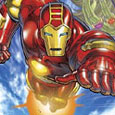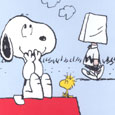Marvel Productions (1994-1995), Buena Vista Home Entertainment (July 5, 2005), 4 discs, 569 mins plus supplements, 1.33:1 original full frame ratio, Dolby Digital 2.0 Stereo, Not Rated, Retail: $49.99
Storyboard:
Four friends go into space and come back transformed into super-powered adventurers.
The Sweatbox Review:
In the 1990s, Marvel Comics was making a big push into animation again, taking advantage of a surge in interest in superhero properties due to Batman’s success in the movies and on television. Fox put X-Men on the air in 1992, followed by Spider-Man in 1994. Also in 1994, two other new shows were placed together to form the syndicated Marvel Action Hour. The two featured cartoons were Iron Man and Fantastic Four, each running two seasons of variable quality. With the new Fantastic Four movie recently out, Disney has just released a box set of the complete 1994-95 series.
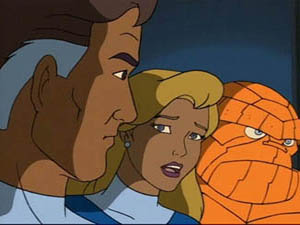
This was the Four’s third outing as an animated series. Just six years after their comic book debut, Hanna-Barbera had brought the Fantastic Four to television in 1967. Those 19 episodes, despite clunky animation, are generally well regarded for being close to the source material. The 1978 show The New Fantastic Four from DePatie-Freleng was a different matter. That show did not even have The Human Torch in it, due to the character already having been optioned for a live-action show. Instead, The New Fantastic Four added a robot named Herbie. The chemistry for the show was therefore totally different from that in the comics, and the poor writing and animation did not help the show find an audience either.
And then came 1994, which would actually see two Fantastic Four projects. There was a low-budget theatrical movie, available now only in bootleg copies, and also the cartoon show. While the live-action movie is notorious for being produced but never released, there are probably a few fans that would have preferred at least the initial season of the TV show held back as well. The thing about making a cartoon based on a property with the word “fantastic” in the title, you see, is that it had better be fantastic. (The makers of the 2005 movie would also have done well to keep that in mind!)
For the most part, adaptations of the Fantastic Four have gotten the set-up from creators Stan Lee and Jack Kirby correct, and that is the case for the 1994-95 show: Four friends take off in an experimental spaceship, get pelted with cosmic rays, and come back to Earth transformed. Reed Richards, the intellectual leader of the group, becomes the pliable Mr. Fantastic. His girlfriend Sue Storm (or in this case his wife, Sue Richards) becomes The Invisible Woman. Sue’s brother Johnny becomes the fire-wielding Human Torch. Lastly, the most sympathetic character is Ben Grimm, who gains terrific strength and invulnerability as The Thing, but has to endure having his body changed into a mass of orange rock. After adjusting as well as possible to their new powers, the group becomes a team of adventurers, taking on various extraterrestrial and extra-dimensional threats, as well as fighting more local but outrageous supervillains. All the while, they still operate as a family unit, complete with an array of dysfunctions. It is a great idea for a series; and as the first true Marvel comic, it set the tone for decades of successful stories of flawed heroes in a world filled with super beings and yet still suffering from human frailty.
Unfortunately, it takes more to adapt a popular comic book than simply putting costumes on characters and have them run around fighting people. At the very least, you must capture the dynamic qualities of comic book art. People like Jack Kirby and John Byrne, after all, have drawn the Fantastic Four’s adventures in the comics. That’s a strong legacy to live up to. Writing-wise, it is very difficult to adapt Marvel Comics, since the typical Stan Lee hyperbole sounds extra-corny when spoken aloud. Nevertheless, that aspect of hyper excitement needs to be maintained.
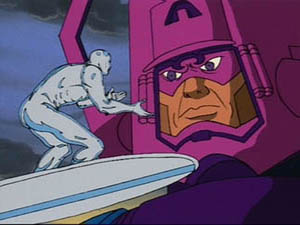
The 1994 season of Fantastic Four failed on most counts. While it was reasonably faithful to the storylines and characters, there is little else going for it. The drawing is often plain bad, with people shifting proportions and generally looking weird and unimpressive. The staging is boring, the layouts are dull, the direction uninspired, and overall the presentation is bland. It could have been much worse, but it hurts more here because it actually looks like they were trying to make a quality program that was true to the comics. Unfortunately, the folks involved in the first season simply did not have the talent to pull it off.
The first season also seems to have had a very rushed production schedule, with copious animation mistakes getting through. Also, check out my “Audio” comments for how much I like their “snappy” theme song from that season. While not a total train wreck, the first season can be viewed as a no-frills bargain coach with a poorly trained staff that barely managed to bring the train safely to its destination. Even the decent stories are sabotaged by blasé execution. Adding to the woes of Season One is the ongoing subplot of their truly annoying landlady at the Baxter Building, who is constantly harping at them, seemingly oblivious to the fact that the Four are world-saving superheroes. Thankfully, she loses her spot on the show when the Fantastic Four movie to Four Freedoms Plaza in the second season.
With Season Two, things pick up considerably. New story editors and writers were hired, and the animation switched from Wang Film Productions to Philippine Animation Studio, granting the cartoon a much more polished and professional look. As soon as you see the second season opening, you know things are going to be different. Characters are drawn in proper proportions, the direction is dynamic, the action is sweeping, and the layouts creative. The first episode in particular has terrific animation, and even if that strong quality cannot quite be maintained, the rest of the season is leaps and bounds ahead of the first. Had the first episode’s quality been fully maintained, I would be tempted to say that Fantastic Four would have been close to being a classic. As it is, the show will always be known for a weak first season, and a pretty good second season.
And now the details, episode-by-episode:
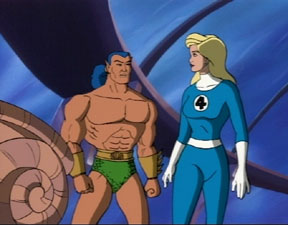
Season One
The Origin Of The Fantastic Four Parts 1 & 2 – Oh, there are so many things wrong about these episodes, laying the unfortunate foundation for what is to come. The Four battle Namor underwater, without breathing gear (this is pretty much explained in the next episode, but should have been mentioned here as well). The Four appear on a Dick Clark telethon, and recount their origin, but I have two problems with that: Who the heck thought that FF fans would want to see Dick Clark, and why does this guy look nothing like Dick Clark? Also, the telethon set looks just like a talk show set— as lacking in imagination as everything else in the show. Johnny has white hair in the first scene of the flashback. Ben speaks, but his lips don’t move at all. For everyone else, the lips appear to be animated to a language other than English, because the lip movement does not match the dialog. Aside from that, the lip movement is just strange. Also: Gary Owens may be a great a voiceover artist, but he did not need to appear as Dick Clark’s sidekick in this episode! The Four, after their accident in the flashback, immediately decide to take on code names and fight for humanity; it all seems pretty fast. Puppet Master is the villain later on, but seems to have no real motive. “Neurokinetic clay” is dopey. I could go on…
I will spare you from listing every mistake and dopey idea from every episode, but you get the gist. Season One is not good. The stories get better, and the animation improves a little over the course of the season, but not enough.
Now Comes The Submariner – Namor of Atlantis (with blue hair!?) unleashes a sea monster, and the FF are there to battle it. Namor kidnaps Sue (soon to be a recurring theme on this show), and threatens the surface world. The chronology of the show is wonky here. In the first episode, the FF recounted a battle with Namor while they were on the telethon. I assumed that the series would continue to be set in the present day, and yet here Namor and the Four do not recognize each other. Does that mean the whole series is a flashback now? Make up your mind, people! The underwater scenes are all filtered through a wavy effect, which is a questionable choice that does little to make the scenes more appealing.
Incursion Of The Skrulls – Johnny and Ben fight over a video game that features the FF versus the outer space menace known as the Skrulls; it’s an odd plot device that seems to serve no purpose whatsoever. A cartoon Bill Clinton, looking not much like the real Bill Clinton, requests that the FF investigate an undersea disturbance. A bad likeness of Stan Lee shows up in mid-story to have the Skrull speech translated, regrettably tearing the viewer out of the story. The Skrulls take on the forms of the FF in order to discredit them. Reed has the FF surrender to the Army, and yet two minutes later he changes his mind and tells them to escape. Except for Stan’s appearance, the story is reasonably decent until it gets silly at the end. How long did Reed think the Skrulls would fall for his ridiculous ploy?
The Silver Surfer And Coming Of Galactus Parts 1&2 – The streaking phenomenon in the sky that the Four encountered prior to their original transformation returns, signaling impending doom. The Silver Surfer has located the Earth, finding it suitable for the world-devouring giant Galactus. The FF gets evicted by their overbearing landlady, just as the nearly omnipotent Watcher arrives at the Baxter Building to explain the coming danger. The Thing’s girlfriend Alicia Masters, who appears throughout the series, figures prominently in the plot here. There’s really a good plot in this one— too bad it did not appear in the better-produced Season Two.
Superskrull – The Skrulls figure out just how lame Reed’s subterfuge was two episodes ago, and they mount another offensive. Superskrull, who has all the FF’s powers, is introduced, but the FF have almost equal difficulty with that darn landlady, who demands $150,000 in repair money. Meanwhile, Ben signs with MTV. Marvel at such lines as, “What humans lack in intelligence, they make up for in stupidity.” There’s a Roseanne Barr joke in here, too, which was totally lost on me.
The Mask Of Doom Parts 1-3 – The Fantastic Four’s enemy Dr. Doom makes his first of several appearances on the show in this three-parter. Doom kidnaps Sue, and coaxes the others to come aboard his ship. He brings them to his castle (a scene which includes a poorly-done multiplane shot that just comes off as weird). Doom wines and dines Sue as the others are held captive, and he relates his origin. Gape as you see his mask smile, and the metal lips move as he speaks. Part 1 ends with a not-scary cliffhanger that gets re-designed for the beginning of Part 2. The second part sees the other three members travel to ancient Greece via Doom’s time machine. Stan Lee gets another cameo in Part 3, which also sees the male members fight in the Battle of Salamis against the Persians while searching for a valuable artifact on Doom’s behalf. This had lots of potential to be a stunning episode, but like the rest of Season One lacks visual pizzazz.
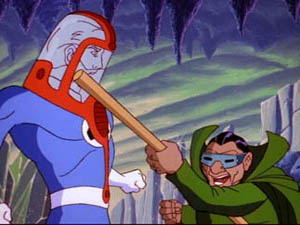
Mole Man – The Mole Man steals world monuments as part of his challenge to the surface world. Prince Charles is the latest in a line of poor likenesses in this season. Johnny’s song and dance number here sets a new low in animation for this show— it’s just scary to watch, but does distract from an awful “Flame On” song. The FF end up underground with everyone else who was attending Rockefeller Center that night, and rely on their landlady to keep the patrons in the Rainbow Room entertained as they go off to fight the Mole Man. This may be the worst Season One episode, although the opening two-parter is close. And here’s a new animation mistake: the FF go transparent in one scene while they run to a window.
Behold The Negative Zone – Annihilus and Blastaar are accidentally released from the Negative Zone, due to Reed and that nosy landlady (her again!). This episode is not all that memorable, although the World Trade Center scene (where Sue notes that the twin towers are nearly “shaken to their foundations”) is momentarily eerie.
The Silver Surfer And The Return Of Galactus – Images from television come to life due to an infusion of life energy. Yes, it’s silly. Dr. Doom appears in order to steal the powers of the Silver Surfer. It’s another decent idea stuck in a substandard episode.
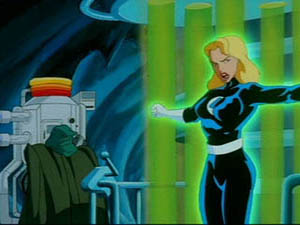
Season Two
Ahhhh, that’s better. Now the show gets cool. The second season’s opening alone has more dynamism than all of Season One. I love this opening, which shows different eras of the Fantastic Four, including a homage to the cover of Fantastic Four #1, and appearances of various versions of their costumes that are true to the evolution seen in the comics. The stories in this season still suffer from lapses of logic and too many coincidences, but that is true to the comics. What Season Two has in greater quantities here is style and talent, which makes one more forgiving of the plotting. Season Two also has lots of guest-stars, making it all the more fun for comics fans.
And A Blind Man Shall Lead Them – The animation in this opening episode is stunning at times, and the character designs get a nice makeover. The costumes now are black with blue highlights, giving them greater dimensionality, and the Thing especially looks more dimensional now that his rockiness is properly shadowed and contoured. Reed’s hair now has a more natural whitening, no longer ridiculously following his hairline. The series adopts a new format too, showing a teaser before the opening. In this one, the FF fight what appear to be Sentinels from the X-Men comics (appropriate in a way, since the show’s look reminded me a lot of the X-Men cartoon in this episode). Even if the Sentinels are misplaced, they do look cooler than last season’s Doombots. The Four lose their powers, and Daredevil helps them to cope as they face Dr. Doom. And thank goodness, Doom looks and sounds much more menacing in this season. (Most importantly, the lips on his mask do not move as he speaks!)
The Inhumans Saga Parts 1-3 (And The Wind Cries Medusa, The Inhumans Among Us, and Beware The Hidden Land) – This kicks off an ongoing arc for this season, introducing the Inhumans and the love of Johnny’s life, Crystal. The story opens with Medusa being a member of the Frightful Four, along with HydroMan, The Trapster, and The Wizard. The Wizard turns Ben against his friends, but they still manage to foil the Frightful Four. Medusa escapes, though, thanks to Johnny. In Part 2, Johnny finds her and helps her to escape Gorgon, as it is revealed that she has amnesia. After she regains her memory, she realizes that Gorgon is an Inhuman like her, and she needs to rejoin her people. Johnny finds a new infatuation with Crystal, Medusa’s sister, and Part 2 ends up with the beginning of a large battle between the FF and the Inhumans. Part 3 reveals the true threat to both groups, and the Inhumans are ultimately cut off from humankind. Great story.
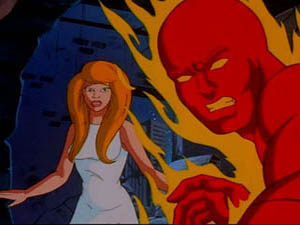
Worlds Within Worlds – Johnny is moping over his loss of Crystal, as Psycho-Man invades the FF headquarters to steal back something Reed took from his dimension. The FF must then shrink down to enter into the Microverse, where they must face off against a tyrant.
To Battle The Living Planet – The Avengers and New Warriors cameo, as disaster strikes New York City. Thor assists the FF in battling Ego, the Living Planet.
Prey Of The Black Panther – The Black Panther tests his skill against the FF before asking for their help against Klaw, Master of Sound. Oh, and Johnny continues to be bummed over Crystal.
When Calls Galactus – Johnny finds a new “flame” (literally!), just as Galactus’s new herald Terrax arrives on Earth. Terrax’s mission, however, is not what you expect… The FF gets some help with some unexpected last-minute guest stars. I like cameos as much as anyone, but the ending has a bit of a deus ex machina feel to it.
Nightmare In Green – Tired of “Hulk versus Thing” stories that leave in doubt who is stronger? Well, don’t worry— this story shows that the big green dude wins by a mile. Dr. Doom is behind the Hulk’s attack on the Fantastic Four. The Scarlet Spider and the X-Men appear ever so briefly.
Behold, A Distant Star – The return of Sue and Johnny’s father leads to his jailing, and then the story dives into intergalactic intrigue.
Hopelessly Impossible – Now here’s the worst of Season Two. The Impossible Man, running from Superskrull, assists the viewer in catching up on Season Two. This is largely a clip episode, and quite skippable. There is a tease that the Crystal storyline will move forward, but that angle leads nowhere.
The Sentry Sinister – After the lousy tease of last episode, things really do happen to advance the Inhumans story. Aside from Black Bolt finding a way to free his people, the FF (minus Johnny initially) encounters a Kree robot sentry while on vacation.
Doomsday – The big finale for the series sees Dr. Doom return once more to steal the Silver Surfer’s powers. This is a bit redundant, but it seems like the second season team wanted to do the story better, and they do succeed. It is still not as good as the Justice League Unlimited series, but it is fairly entertaining. The New Warriors and Avengers cameo.
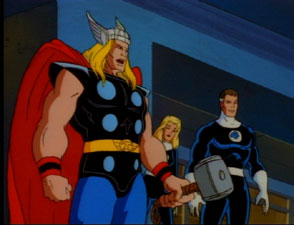
Is This Thing Loaded?
Stan Lee’s Soapbox (7:45) sees Stan discuss the origins of the FF, confirming that they came about when the publisher told Stan he wanted a book that could emulate the success of DC’s Justice League. He talks about how he sees the FF, and how they are written. There is not much new here for long-time fans, but I was most interested to hear him say that he is flattered by hearing how much of The Incredibles (which he had not seen) was inspired by The Fantastic Four.
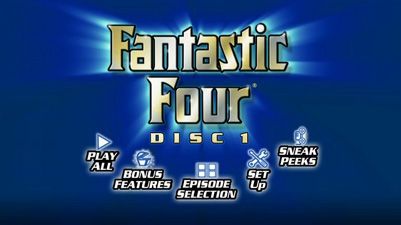
Episode Introductions By Stan Lee are available for each episode. You can choose to play them with the episodes (either individually, or with “Play All”), or you may view the intros separately. They are about half a minute each, and basically give you the type of information you would usually find in your TV listings, but provided with Stan’s trademark enthusiasm. Oddly, the original intros Stan filmed for these shows are not present. The intros on the DVDs are new, done at the same time as the Soapbox piece.
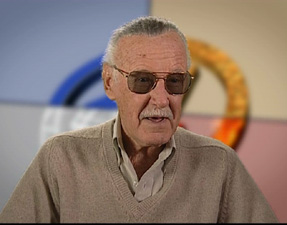
There are also Previews on Disc One, for Chicken Little, Chronicles Of Narnia, Hitchhikers Guide To The Galaxy, Spider-Man: The ’67 Collection, Spider-Man: The Venom Saga, Scrubs: Season One, The Pacifier, and Power Rangers SPD.
Case Study:
The four DVDs come in a nicely designed foldout pack, fit inside a slipcase. The main drawback for some will be that the discs appear in pairs, one on top of the other. I know that many hate this approach, but I do not think it is a big deal. I am all for any scheme that saves shelf space. Of course, they could have used two-sided slimpacks too, resulting in a similar case size.
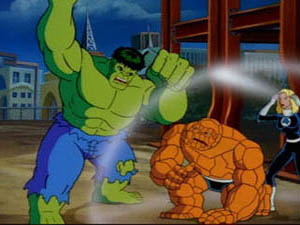
One might expect that the four DVDs would naturally be divided two per season, but the episodes are not evenly distributed. Disc One has 7 episodes, and Disc 2 has seven more, ending bizarrely with the first episode of Season Two. (So, don’t think you can throw out the first two discs, in case you wanted to dump Season One.) Disc 3 has 8 episodes, and Disc 4 has only 4 episodes. Disc 4 is the key— the episodes were distributed as they were to allow the final disc to be single-layered, saving replication costs.
Ink And Paint:
While one cannot blame the DVD makers for the banality of Season One, I can nitpick about the shimmering that shows up in the image there. There is also an inappropriate return of the “wavy” effect for two minutes in Superskrull that is weird. For some reason, the Season Two episodes got better mastering, looking pretty stable. The prints for both seasons are generally quite good, with only occasional blemishes. There is a lack of sharpness, though, that inexpensive TV animation often has.
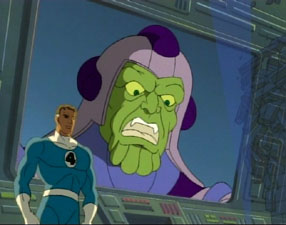
Scratch Tracks:
Even the first season has a decent stereo mix, although Season Two probably packs more punch and makes a stronger impression. As far as stereo soundtracks go, this is one of the more active ones I have heard, though certainly not the very most impressive. Overall, I can’t complain here. Only English is offered though, as well as a sole English subtitle track.
And now, a word about the first season’s Fantastic Four theme song… It is insipid. It reminded me of nothing so much as a radio jingle, something that you would have come up with if given only two minutes. Naturally, the darn thing stuck in my head all week while I was watching these episodes. The music during the first season episodes is bad as well, like synthesized stock music that reminded me of the music from Terrahawks (brrr….shiver!). Like everything else, the second season fares far better. The peppy theme song is dumped for a rousing instrumental piece, and the episodes get decent scores as well.
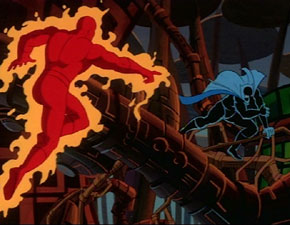
The show is well cast for both seasons, for the most part. Beau Weaver strikes a perfect balance of being intellectual and caring as Reed, and Lori Allan emotes naturally as Sue Richards. Chuck McCann seems a little over the top as The Thing, but still manages to be both fun and sincere. Johnny Storm was played by Brian Austin Green in Season One, while Quinton Flynn took over in Season Two; they both do very good jobs. The guest stars do well too, particularly John Rhys Davies as Thor, Michael Dorn as Gorgon, and Ron Perlman as the Hulk. Mark Hamill will almost always sound too much like the Joker to me when he does voiceovers, but he is notable as Maximus.
Doctor Doom got switched in-between seasons too, which was definitely a change for the better. In the first season, Doom sounded like he was putting on a goofy Arnold Schwarzenegger accent. In Season Two, Simon Templeman voices a cool, aristocratic English accent that is much more malevolent.
Final Cut:
Obviously, this is a show that has varying levels of quality to it, largely divided between its two distinct seasons. Fans of the Fantastic Four will enjoy this set, but even they may be disappointed in the quality of the awkward first season. Superhero fans looking for a meaty package will find greater rewards in the Batman: The Animated Series sets. Truthfully, both seasons of the show are probably better than most seasons of the Super Friends were, in terms of overall animation and story quality; but Season One of FF is very bland, and Season Two still comes off a bit like the plain girl making herself pretty for the prom, but still not really having the personality to become the homecoming queen. One is left with the sense that there is a better Fantastic Four series waiting to be produced someday. Until that definitive version is made, I would say that anyone having an interest in this set should pick it up— especially if you find it for a low enough price that allows you to forgive yourself for purchasing Season One.
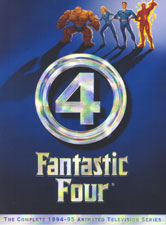 | ||
 |






